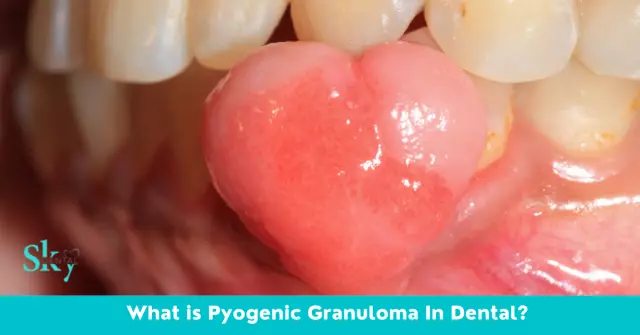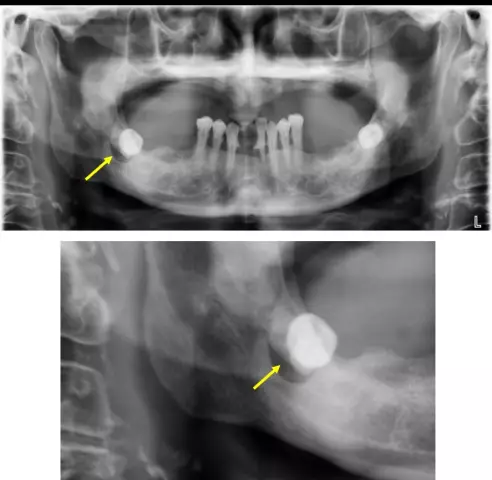- Author Rachel Wainwright [email protected].
- Public 2024-01-15 19:51.
- Last modified 2025-11-02 20:14.
Tooth abscess
The content of the article:
- Types of dental abscess
- The reasons
- Symptoms
- Diagnostics
- Treatment
- Forecast
- Prevention
- Video
Inflammation of tissues with their subsequent melting and the formation of a limited purulent cavity is called an abscess. When the process occurs on the inner or outer surface of the alveolar process of the upper or alveolar part of the lower jaw, then we are talking about a tooth abscess. The cause of its appearance is a bacterial infection that accumulates in the gum area, dental pocket, fibrous connective tissue that fills the dental cavity. Since it contains a large number of nerve endings, blood and lymph vessels, the pathology is accompanied by edema and severe pain. Finding and removing the source of infection is the main task of treating the disease.

Tooth abscess is an abscess located in the periodontal tissues
Types of dental abscess
Depending on the structures involved in the infectious inflammatory process, there are several types of dental abscess.
| View | Characteristic |
| Gingival (often called gumboil) | The infection affects only the gum tissue, without affecting the root and periodontal ligament. |
| Periodontal | An abscess affects the periodontal tissue (tissue that fills the space between the tooth socket and the root of the tooth). |
| Periapical | Inflammation and accumulation of pus occurs in the pulp of the tooth, then spreads through the apex to the surrounding soft tissue. |
An abscess in the periapical region can occur with or without fistula formation. In the presence of a fistulous passage, an abscess and the following formations may be reported:
- maxillary paranasal sinus;
- nasal cavity;
- oral cavity;
- skin surface.
The reasons
The oral cavity is a complex ecosystem of microorganisms. Most of the microflora is conditionally pathogenic, showing its disease-causing properties while reducing the body's resistance, which leads to:
- frequent viral and bacterial infections;
- endocrine diseases;
- immunodeficiency states.
In addition to the general factors that contribute to the manifestation of the virulent properties of microorganisms, local conditions that support the inflammatory process play a role.
| Localization of the abscess | Cause and mechanism of occurrence |
| Gingival, or subgingival | It occurs when there is a pathological pocket between the gum and the tooth, in which plaque accumulates and inflammation develops, or as a result of mechanical trauma to the gum (solid food, a hard toothbrush when brushing, a toothpick, a poorly fitted prosthesis, etc.) with the addition of an infection. |
| Periodontal | It is formed during an exacerbation of chronic inflammation of the periodontium: a predisposing factor (deposits of tartar, preserved circular ligament, filling or prosthetics errors) causes microcirculation disorders, a decrease in oxygen supply to tissues, and the activation of pathogenic flora leads to a purulent process. |
| Periapical | It develops as a result of root canal infection during periodontal inflammation. They provoke purulent tissue damage in the root apex: traumatic injuries with rupture of the main neurovascular bundle, overheating of the pulp when preparing teeth before prosthetics, toxic effect on the pulp of photopolymer filling materials with deep caries, poor-quality filling of dental canals. |
Symptoms
The clinical manifestations of the disease are determined by its localization.
| Localization of the abscess | Clinical manifestations |
| Gingival | Pain that increases with pressure, eating, brushing teeth. There is swelling, redness of the gums, protrusion in the place of accumulation of pus. Pain increases in intensity in response to hot, solid food. |
| Periodontal |
In the acute stage of the process, pain of varying intensity worries, spreading to the adjacent teeth: first aching, then sharp, pulsating, and then constant and unbearable. The patient experiences problems when chewing food, the closing of the jaws causes an increase in pain, and pathological mobility of the diseased tooth appears. Regional lymph nodes increase, the general condition worsens. The gum swells, redness, cyanosis, sharp soreness when pressed and the discharge of purulent exudate from under the edge of the gums are detected. The chronic process is characterized by the presence of a fistulous passage, from which a discharge periodically appears, this is sometimes the only complaint. |
| Periapical | An acute process, not accompanied by the formation of a fistulous tract, is manifested by a dull throbbing pain, aggravated by chewing or pressure on the tooth. Painful swelling, hyperemia of the mucous membrane is determined, a deep carious cavity or filling is usually visualized on the chewing surface of the affected tooth. The general condition is deteriorating. If a fistulous passage has formed, then the complaints are less pronounced: the pain is periodic, aching, a fistula, granulation is found on the mucous membrane. |
Diagnostics
To make a diagnosis, the dentist conducts:
- patient interview;
- examination of the oral cavity;
- X-ray (the photo reflects the condition of the periodontal tissues);
- electroodontodiagnostics (assessment of the state of the nerve elements of the pulp using electric current);
- contact thermography (a method for detecting inflammation in soft tissues, blood vessels, lymph nodes using liquid crystals that react with a color change to heat radiation);
- laboratory examination (clinical blood test, cytological and molecular genetic study of the composition of the microflora of the periodontal pocket).
Differential diagnosis is carried out with the following diseases:
- acute periodontitis;
- exacerbation of chronic periodontitis;
- periostitis;
- osteomyelitis;
- suppuration of the radicular cyst.
Consultation with a dental surgeon is required.
Treatment
It is necessary to treat the pathology in a comprehensive manner, combining surgery with the appointment of antibacterial, anti-inflammatory and analgesic drugs.
| Abscess type | Healing activities |
| Gingival | The incision of the gums in the area of greatest protrusion, removal of pus, rinsing the cavity, creating conditions for a full outflow of inflammatory exudate, taking antibiotics, anti-inflammatory drugs, rinsing with antiseptic agents. During the period of remission, it is possible to prescribe physiotherapy, dynamic observation. |
| Periodontal | Opened in the area of maximum protrusion of the mucous membrane, remove pus, dead tissue, wash with antiseptic solutions, provide adequate drainage. Prescribe antibiotics (lincosamides, macrolides, fluoroquinolones), non-steroidal anti-inflammatory, antiprotozoal, pain relievers, rinsing with antiseptic solutions. |
| Periapical | In order to ensure a full outflow of pus, access to the dental canals is created, their instrumental and medical treatment is carried out, and they are expanded. The dental cavity is left open, rinses, antibiotics, and, if necessary, non-steroidal anti-inflammatory drugs are prescribed. After the inflammatory process subsides, a temporary filling is placed, observed in dynamics, X-ray control is carried out, in the absence of inflammation, the channels are sealed with a permanent filling material. In some cases, adequate drainage can be achieved through a soft tissue incision. If there are fistulous passages and granulations, they are excised. |
Attention! Photo of shocking content.
Click on the link to view.
Without fail, patients undergo oral cavity sanitation: removal of hard plaque, treatment of caries and its complications.
Forecast
With timely access to dental care, the prognosis is favorable, in many cases it is even possible to save the tooth.
For the periapical localization of the abscess, the prognosis is favorable in the absence of pathological destructive changes on the roentgenogram. If the abscess in the root apex is a consequence of chronic granulating or granulomatous periodontitis, the long-term consequences are largely determined by the age and state of the patient's immune system.
Prevention
For prevention purposes, it is necessary:
- observe oral hygiene;
- change your toothbrush at least once every three months;
- eat rationally, do not abuse sweets;
- visit the dentist at least once a year.
Following these rules will avoid many problems.
Video
We offer for viewing a video on the topic of the article.

Anna Kozlova Medical journalist About the author
Education: Rostov State Medical University, specialty "General Medicine".
Found a mistake in the text? Select it and press Ctrl + Enter.






